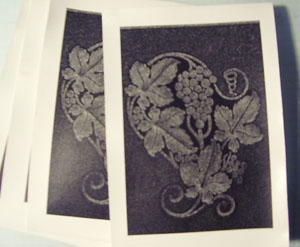|
by Ed Buffaloe
 After a bromide print is bleached, some practitioners soak
it in an acid bath to remove the color, resulting from residual chromium, which is variously described as a light grey, green, or blue. Welborne Piper did not use an acid
bath--he resorted to Farmer’s Reducer to “fix” his image, though his editor stated it was to remove the “under image.” C. H. Hewitt, writing in 1908 stated “...for ease in
pigmenting it is necessary that the untanned portions be swelled by the absorption of water. A bath of weak sulphuric acid hastens this swelling.” The acid bath may
have been necessary to soften the gelatine after bleaching in the early ferricyanide bleaches. Later it seems to have been used primarily to remove color from
the bleached image, though some practitioners still maintain that it can improve inking qualities. David Lewis, in his book, The Art of Bromoil and Transfer, says that 2 or 3 minutes in a 1 to 2%
solution of sulphuric acid “facilitates inking” of the matrix, but that he has found the acid can damage the paper when used before fixing, so he now uses it after fixing. I have tried using an
acid bath, both before and after fixing, but found it made the print more difficult to ink. I even tried using a much milder solution, but still had problems with uneven inking and the ink not taking well overall. After a bromide print is bleached, some practitioners soak
it in an acid bath to remove the color, resulting from residual chromium, which is variously described as a light grey, green, or blue. Welborne Piper did not use an acid
bath--he resorted to Farmer’s Reducer to “fix” his image, though his editor stated it was to remove the “under image.” C. H. Hewitt, writing in 1908 stated “...for ease in
pigmenting it is necessary that the untanned portions be swelled by the absorption of water. A bath of weak sulphuric acid hastens this swelling.” The acid bath may
have been necessary to soften the gelatine after bleaching in the early ferricyanide bleaches. Later it seems to have been used primarily to remove color from
the bleached image, though some practitioners still maintain that it can improve inking qualities. David Lewis, in his book, The Art of Bromoil and Transfer, says that 2 or 3 minutes in a 1 to 2%
solution of sulphuric acid “facilitates inking” of the matrix, but that he has found the acid can damage the paper when used before fixing, so he now uses it after fixing. I have tried using an
acid bath, both before and after fixing, but found it made the print more difficult to ink. I even tried using a much milder solution, but still had problems with uneven inking and the ink not taking well overall.
Emil Mayer doesn’t mention the acid bath, but I noticed that he mixes his fix at 20% and acidulates it with 12 grams of potssium metabisulphite per liter. Jill Skupin Burkholder told me that she once
dropped a matrix in Dan’s EDTA solution for platinum printing and saw that it removed the color, so she now uses an EDTA bath. Despite my earlier failures, I decided to do a test in which I
would make four prints on Agfa Multicontrast Classic paper, develop them identically, bleach them identically, but try 4 variations on fixing and clearing as follows:
I. The first print would be fixed in a 10% hypo solution and receive no other processing than a wash.
II. The second print would be fixed in a 10% hypo solution and given a 3 minute bath in distilled water with 2 drops of strong sulphuric acid per ounce of water.
III. The third print would be fixed for 5 minutes in a 20% hypo solution with 12 grams per liter of sodium bisulfite added (I didn’t have potassium metabisulfite).
IV. The fourth print would be fixed in a 10% hypo solution, followed by 3 minutes in a 5% solution of EDTA disodium.
I measured the pH of the two fix solutions as well as the two after-bath solutions. Then, after bleaching, I measured the reflection density of the paper base, a high value portion of the matrix,
and a shadow area.
|
|
pH of Solution
|
D Paper Base
|
D High Value
|
D Shadow
|
|
10% hypo only
|
8.32
|
.10
|
.13
|
.19
|
|
10% hypo + 3m in sulphuric acid sol.
|
5.01
|
.08
|
.10
|
.13
|
|
20% hypo w/ sodium bisulphite
|
1.99
|
.07
|
.09
|
.13
|
|
10% hypo +3m in 5% EDTA disodium
|
4.64
|
.07
|
.09
|
.12
|
|
After drying overnight, I soaked all four prints in room temperature water (67° F or 19.5 ° C) and inked them with a roller. The bleached matrices looked like this before they were fixed:
Click on the picture above to step through the results of my experiment.
Click on one of the small images below to see any step in the process,
or click on the last image to see my conclusions.
|

